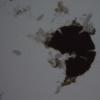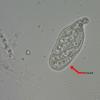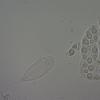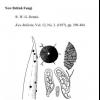
16-11-2025 21:09
 Robin Isaksson
Robin Isaksson
Anyone recognize this acc. to pictures.? Found on

14-11-2025 16:26
 Marian Jagers
Marian Jagers
Hello everyone, On dead wood of Cytisus scoparius

15-11-2025 23:22
Mario FilippaHello,this is what I think to be Hymenoscyphus mac

15-11-2025 20:25
 Riet van Oosten
Riet van Oosten
Hello, Found by Laurens van der Linde, Nov. 2025

14-11-2025 18:31
 Lothar Krieglsteiner
Lothar Krieglsteiner
Hello,can somebody provide me with a file of:Rothe

12-11-2025 09:25
 Viktorie Halasu
Viktorie Halasu
Hello, I need help with a pale terrestric Pseudom

11-11-2025 20:16
Bohan JiaHi, lastly I have found these tiny yellow decayin

09-11-2025 13:20
Hello.A tiny ascomycete, appearing as erupting gra
Microthyrium-like on Juniperus
Marc Detollenaere,
23-06-2023 15:16
 Dear forum,
Dear forum,On the leaves of Juniperus sp. I found some small black thyriothecia with a diameter of about 0.2-0.25mm. The scutellum was composed of quadrilateral cells radiately arranged. The cells were markedly longer than wide.Asci measured 53x22µ, 8-spored, bi- and triseriate.Spores measured 21.5x8µ , hyaline, 1-septate. Each cell of the spores contained a large guttule and several small ones.
Any help would be appreciated.
Marc
François Bartholomeeusen,
24-06-2023 08:27
Re : Microthyrium-like on Juniperus
Dag Marc,
Seynesiella juniperi is misschien wel de oplossing?
Zie item Piet Bormans http://ascofrance.fr/forum/19328/seynesiella-juniperi
Groeten,
François
Seynesiella juniperi is misschien wel de oplossing?
Zie item Piet Bormans http://ascofrance.fr/forum/19328/seynesiella-juniperi
Groeten,
François
Hi Marc,
Seynesiella juniperi might be the solution?
See item Piet Bormans http://ascofrance.fr/forum/19328/seynesiella-juniperi
Greetings,
François
Marc Detollenaere,
24-06-2023 15:13

Re : Microthyrium-like on Juniperus
Dag François,
Bedankt voor de bijkomende info. Met die sleutel kom ik ook uit op Microthyriaceae.
Aan Seynesiella had ik niet gedacht omwille van de grote guttulen die niet vermeld worden in E&E en omdat ik in de sleutel van de Microthyriaceae gekozen had voor saprotrofe soorten met hyaliene sporen.Seynesiella wordt beschreven als parasiet met licht gekleurde sporen. In een vroegtijdig stadium blijken die echter wel hyalien te zijn.In Dennis ( dank voor de referentie ) staan de grote guttulen wel beschreven.
Alles wijst inderdaad op Seynesiella juniperi.
Marc
Bedankt voor de bijkomende info. Met die sleutel kom ik ook uit op Microthyriaceae.
Aan Seynesiella had ik niet gedacht omwille van de grote guttulen die niet vermeld worden in E&E en omdat ik in de sleutel van de Microthyriaceae gekozen had voor saprotrofe soorten met hyaliene sporen.Seynesiella wordt beschreven als parasiet met licht gekleurde sporen. In een vroegtijdig stadium blijken die echter wel hyalien te zijn.In Dennis ( dank voor de referentie ) staan de grote guttulen wel beschreven.
Alles wijst inderdaad op Seynesiella juniperi.
Marc





